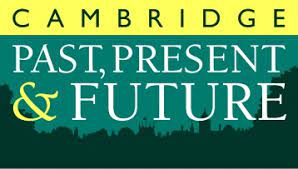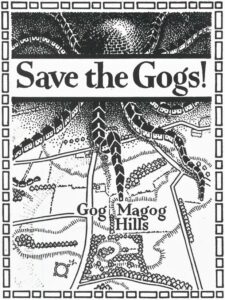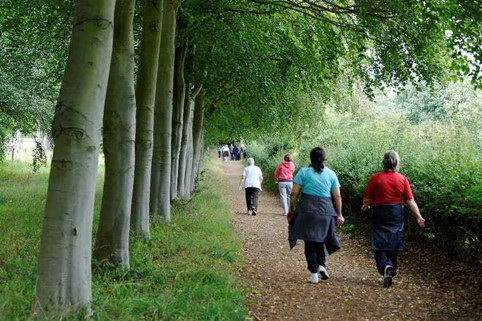Cambridge’s first country park is celebrating 70 years
 Local charity Cambridge Past, Present & Future is celebrating 70 years of Wandlebury Country Park. On 26 April 1954 it announced that it was buying the Wandlebury Estate to make it a public open space. It became Cambridge’s first Country Park and has provided generations of people with a beautiful greenspace to enjoy. With the help of the charity’s supporters, they have also been able to protect the nationally important iron-age archaeology, maintain historic buildings and provide a home for nature.
Local charity Cambridge Past, Present & Future is celebrating 70 years of Wandlebury Country Park. On 26 April 1954 it announced that it was buying the Wandlebury Estate to make it a public open space. It became Cambridge’s first Country Park and has provided generations of people with a beautiful greenspace to enjoy. With the help of the charity’s supporters, they have also been able to protect the nationally important iron-age archaeology, maintain historic buildings and provide a home for nature.
James Littlewood, the charity’s Chief Executive, is helping to lead the celebrations, “we know how much pleasure Wandlebury has given to generations of people and we are proud of our work to increase nature and preserve history. One of the ways we are marking this special birthday is by launching an appeal to raise £70,000 so that Wandlebury continues to be an amazing place for the next 70 years. Details of the appeal have just been made available at www.cambridgeppf.org We are also asking people to help us reflect on Wandlebury’s 70th by sharing their special memories with us on social media using the #Wandlebury70.”
Bill Clark was the Warden at Wandlebury from 1973-1997 and still lives on the estate, one of his special memories is how he created the first meadow and gave it a name “Getting the charity to agree to turning the wheat field into a flower meadow, was not as easy as I expected. The majority believed keeping financially solvent was very important – and rightly so, for the charity was living hand to mouth, and did not want to forego the cash the crops brought in. I persevered, gaining some sympathy by announcing that 85% of England’s chalk grassland had disappeared – years later, satellite technology proved it was more like 95%! Permission was finally given when the Countryside Commission agreed to grant-aid the meadow, although only on condition that we named it for a specific public use, so I named it the ‘Picnic Field’.”
Save the Gogs
 The rolling chalk hills on the southern edge of Cambridge have held a special attraction to people for over 2300 years. On top of the Gog Magog Hills, or “the Gogs”, lies the remains of a large and important circular Iron-Age fort, where the Iceni tribe lived. The Romans arrived and built a road over the Gogs that connected Cambridge to Colchester.
The rolling chalk hills on the southern edge of Cambridge have held a special attraction to people for over 2300 years. On top of the Gog Magog Hills, or “the Gogs”, lies the remains of a large and important circular Iron-Age fort, where the Iceni tribe lived. The Romans arrived and built a road over the Gogs that connected Cambridge to Colchester.
From 1865 the race horses of King Charles II and King James II were trained there. In the 1730s a country estate and stables were built there by the Duke of Leeds, where the famous Godolphin Arabian sired a generation of thoroughbred race horses. Although Wandlebury was a private estate it was a popular place when opportunity allowed: in 1933 18,000 people attended a fete at Wandlebury that was addressed by the Prime Minister.
As housing started to sprawl out of Cambridge in the 1920s the wonderful views from the Gogs made it an ideal place to build a house. By the early 1930s Cambridge Past, Present & Future became seriously concerned that without intervention the hills would be built over, destroying them forever. They launched a major ‘Save the Gogs’ appeal with the aim of raising a large sum of money to pay landowners to give up their development rights.
Although they raised the equivalent of £1.1m in today’s money, it was not enough. As fate would have it, World War 2 intervened and afterwards more effective planning legislation was introduced which, with their campaigning, protected the Gogs from development.
Following the deaths of Sir Harold and Lady Gray, in 1953 their son Terance began seeking a purchaser for the Wandlebury Estate, which was in a seriously neglected condition. Frantic negotiations and discussions took place to secure Wandlebury for public benefit and the charity resolved to use the ‘Save the Gogs’ money for this purpose. Even with the offer of these funds, the County Council could not be persuaded to buy the estate and so it fell to Cambridge Past, Present & Future to step up. There is no doubt that without the generosity of Terance Gray this would not have been possible; he effectively gifted half of the estate.
70 years of hard work
1950s The estate was neglected and unsafe and had to be put it into a suitable condition so that it could be opened to the public as a park.
1960s The first Wandlebury Warden was employed and teas were served from what is now the charity’s office.
1970s Storms and droughts resulted in a devastating loss of large trees. This was followed by mass tree planting activity, including The Avenue of beech trees. The first meadow was created.
1980s Dutch Elm Disease and the ‘Great Storm’ of 1987 resulted in another bought of tree loss and tree planting. A large meadow was created. The 15th century Tadlow Granary was rebuilt to its former glory.
1990s The historic orchard was restored.
2000s 10 acres of farmland was purchased to extend the park and it was planted with trees and sown as a meadow. A dilapidated stable was transformed into a new Outdoor Education Centre, since visited by over over 20,000 school children.
2010s A wildlife viewing hide was built, a pond was restored in the middle of the park and Highland Cattle arrived. Pop-up café’s started serving visitors.
2020s 25 acres of land was purchased to extend the park and is being turned into high quality habitats. A dog exercise area has been opened.
Images courtesy of Cambridge Past, Present & Future.

